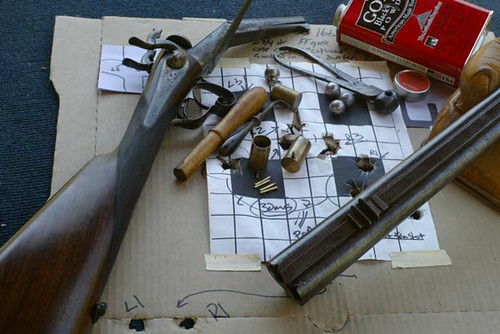| tinker |
| (.416 member) |
| 31/01/06 02:28 PM |

|
|
|
I know for sure there are guys here with more to say and with more experience than I do, but here's what I do as a typical 'handshake' with a double that I'd consider buying.
First thing I'll do is handle it like I was about to shoot it. If it fits and/or isn't too far off being a good fit I continue. I'll peel the forend off and try my best to twist the barrels off the gun while twisting the wrist of the stock in the opposite direction. I do that both ways, back and forth to see if I can see or feel any kind of movement on the pin with the gun locked up. I'll look for any kind of gap between the standing breech of the action and the barrel breeches with the gun locked up. I look to see that the seam where the action flats and the barrel flats are is the same from one side of the gun to the other, and if there is a gap I look and if I have feeler guages handy I test it to see that the gap is paralell and the same all around the joint.
I'll take the barrels off and bang them against the butt of one of my hands to see if I can get the barrels/ribs to make any kind of clanking, clicking, or other noise that'd say there was a loose rib or a crack or what have you.
I'll sight through the bores as well as I can and usually having a fiber optic extention for a light with me I'll light the chambers and bores up and look for any kind of troubles like poorly done lengthened chambers or sleeve jobs. I'll typically try to peel the ribs off with a fingernail.
I sight down the outsides of the barrels, all around both of them looking for bulges where they shouldn't be, on reblacked guns I look for signs of *more* striking in some places than others, and if I find signs of that I look very closely around those areas for signs of upset to the rib joints or lugs/swivels/mounts in the area.
If I can I cast the chambers and slug the bores on the spot. I slug the barrels from both ends. I typically also have with me telescoping guages, adjustable small hole guages, and a micrometer or caliper or both.
I look at the lumps to see if there's been any doctoring there like solder or dovetail or peening jobs, I look at the proofs to see if there's been any re-proofing or repair proofs on the gun anywhere. I look at the muzzles for recessed crowns and at the rib to barrel joints for out-of-character solder work.
On the action I note how far the closing lever throws on lockup. I'll wiggle it to see if it's showing any signs of wobble or wonk. I'll look at the locking lugs as well as I can to try to detect peening or signs of welding. I look at the striker tips, the striker bushings, and the cocking dogs if present, I note to myself if there is or isn't grease where I think there should be grease. I look at where the standing breeches meet the action flats and inspect very closely for any sign of cracking. If it's a hammer gun I'll wiggle the hammers to make sure they're tight on thier spindles, if they wiggle I'll note if it's just loose hammers on spindles or loose tumblers in the locks. I'll try to force the hammers past halfcock position, I'll test the rebounding feature if they're rebounding locks. I'll gently cycle the locks with the hammer in the fingers of one hand and the gun in the other trying to feel for any kind of scrape or grind that shouldn't be there as the locks cycle.
I test the safeties.
I put the gun back together and lock it up, hold it by the barrels and whack my off hand with the stock listening for rattles or any sounds that might say there's a crack or loose fit or gap somewhere.
I inspect the wood for cracks and repairs, with special attention paid in and around the checkering at the wrist -- especially on a gun where there's been pickup work done on that area and no wood refinish elsewhere. You can hide a lot in a checker refresh job. I also look for signs of gun oil in the wood near the head of the stock.
I look at the screws and/or pins to see if there's been unauthorized buggering or incompetent repair of said pins and screws.
If I have them I run snap caps through the gun and see if the ejectors/extractors seem to work as they should. If the gun has cocking indicators, selective ejectors, or a single trigger, I make double darn sure I've worked the thing through whatever possible combinations I can think of to see that all's working right.
If it's a drilling or combination gun and has an automatic flip sight I check that for function. If set triggers are present I test them as well.
If there are sling swivels in the wood or on the barrels I give them hearty tugs to see if they're loose or damaged.
I'll then hand the gun to whoever else is present and ask them to find anything I've missed.
--Tinker